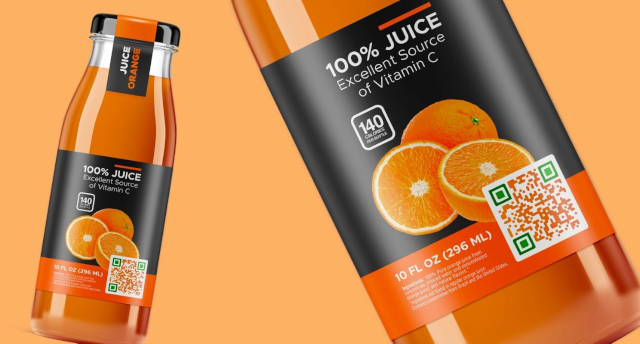The question is dividing the tech’s developers and users. And the economics of the switch have their issues, as well. But the retail sector insists the traditional Bar Code system is fast becoming too restrictive to suit its evolving requirements…
 Example of how a product QR code could be incorporated into label design…
Example of how a product QR code could be incorporated into label design…
When the Bar Code first came into widespread use, it was hailed as a be-all and end-all way of as-signing scanning codes to products. And it’s since been adapted to other uses the inventors never envisioned…
Creative uses abound
Though Bar Code technology was originally intended simply to make products ‘scannable’, speeding up processes such as inventory taking and supermarket checkouts, it was quickly ploughshared into other functions. Most railway freight cars today have tracking bar codes on their sides which can be read as trains speed past stationary trackside scanners. Ditto truck transport trailers.
Produce growers are just now getting around to trying out laser-tattooing or inkjet printing bar codes onto individual pieces of fruit or veggies. Bar Code tech-nology has been adapted to keep rack of in-dividual zebras in the wild, and even honey bees. Anything with stripes on it.
So, one might well ask, why do we need to go to a whole new system, after just 50 years?
An ‘open’ system
First and foremost, the new system the tech world has agreed on as the Bar Code’s successor – the QR code – is accessible via smart phone. And it has a capacity to directly carry directly, within it, information that is many times greater than that of the Bar Code.
That means shoppers can use their phones – equipped with new ‘reader’ apps – to access directly a wide variety of information about any product. And that could well include more information than the product’s own label could accommodate in conventional words symbols. We all know how frus-trating it can be to try to read long ingredient lists or instructions on conventional labels when the information has to be compressed into extremely small print to fit!
Answering consumer demand…
The truth is, conventional Bar Code system is technically be expandable to accommodate more than 10 trillion distinct items. But it’s per-item system for storing information on those items is restricted to just 7 data points each. And consumers are apparently clamouring for access to more information about the products they’re buying.
“This [change] has been in the works for some time, but COVID really accelerated it,” says Anne God-frey, CEO of GS1 UK, the agency that registered product Bar Codes there.
“During the pandemic, everyone got used to pointing their phones at QR codes in pubs and restaur-ants to access the menu,” she continues. “Increasingly, QR codes that bring up bits of infor-mation are already appearing on the front of many products.”
In that context, it seems reasonable that, “Very soon we will say goodbye to the old-fashioned Bar Code, and every product will just have one QR code that holds all the information you need.”
Behind the scenes…
Godfrey reveals that product manufacturers are already adapting their hardware and software sys-tems to work with QR codes. And many retailers – in the UK, at least – are already upgrading their checkout scanners to work with them. But a significant number of retailers are railing at the cost of the changeover, both in system updates and staff retraining…
Even though consumers are just beginning to see more QR codes on product labels, Godfrey says the overall rollout of the new codes in the retail sector could well be complete by the end of 2027.
A few drawbacks?
I see some drawbacks to replacing Bar Codes with QRs. First, as an old-school phone user, I don’t have a mobile data plan. Will I need one – or even a new phone – to access QR codes on products ‘live’, in the supermarket?
When I first heard about the replacement of the Bar Code with QRs, I wondered if QRs are scannable via ‘swiping’. Or do they have to be held stationary in front of a scanner, as they do when phone users take a photo of them? Retailers are updating their equipment, but will scanning QR codes be signif-icantly slower than scanning conventional Bar codes? The lines at supermarket checkout are already crazy-long at peak times, as it is…
My take
I guess the tech people and the retail sector are planning to just ‘bull-on’ through, and tackle glitches in the new system as they arise. And as usually happens when new ‘standards’ are brought into the marketplace, it’s consumers who will be frustrated and inconvenienced in the process.
The tech people and retailers will – predictably – smile, wink and say, “Well, that’s the just the price of progress!”
~ Maggie J.

